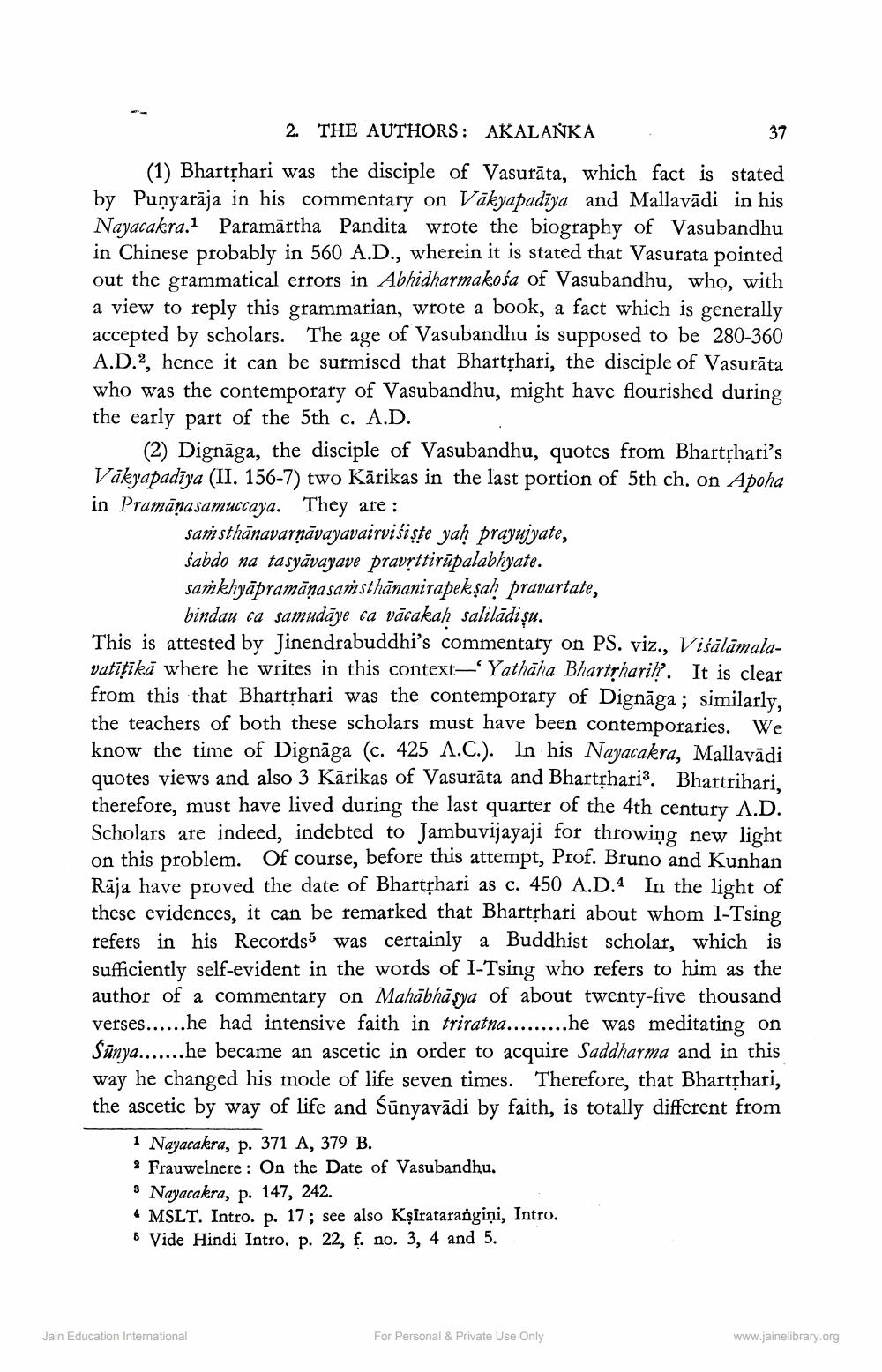________________
2. THE AUTHORS: AKALANKA
37
(1) Bhartphari was the disciple of Vasurāta, which fact is stated by Punyarāja in his commentary on Vākyapadīya and Mallavādi in his Nayacakra. Paramartha Pandita wrote the biography of Vasubandhu in Chinese probably in 560 A.D., wherein it is stated that Vasurata pointed out the grammatical errors in Abhidharmakośa of Vasubandhu, who, with a view to reply this grammarian, wrote a book, a fact which is generally accepted by scholars. The age of Vasubandhu is supposed to be 280-360 A.D.2, hence it can be surmised that Bhartshari, the disciple of Vasurāta who was the contemporary of Vasubandhu, might have flourished during the early part of the 5th c. A.D.
(2) Dignāga, the disciple of Vasubandhu, quotes from Bhartphari's Väkyapadīya (II. 156-7) two Kārikas in the last portion of 5th ch. on Apoha in Pramānasamuccaya. They are :
samsthānavarnāvayavairvišiște yaḥ prayujyate, sabdo na tasyāvayave pravrttirūpalabhyate. samkhyāpramāņa samsthānanirapekṣaḥ pravartate,
bindau ca samudāye ca vācakah salilādi şu. This is attested by Jinendrabuddhi's commentary on PS. viz., Viśālāmalavatīțīkā where he writes in this context— Yathāha Bhartrharih. It is clear from this that Bhartrhari was the contemporary of Dignāga; similarly, the teachers of both these scholars must have been contemporaries. We know the time of Dignāga (c. 425 A.C.). In his Nayacakra, Mallavādi quotes views and also 3 Karikas of Vasurāta and Bhartrhari3. Bhartrihari therefore, must have lived during the last quarter of the 4th century A.D. Scholars are indeed, indebted to Jambuvijayaji for throwing new light on this problem. Of course, before this attempt, Prof. Bruno and Kunhan Rāja have proved the date of Bhartphari as c. 450 A.D.4 In the light of these evidences, it can be remarked that Bhartshari about whom I-Tsing refers in his Records5 was certainly a Buddhist scholar, which is sufficiently self-evident in the words of I-Tsing who refers to him as the author of a commentary on Mahābhāsya of about twenty-five thousand verses......he had intensive faith in triratna.........he was meditating on Sünya.......he became an ascetic in order to acquire Saddharma and in this way he changed his mode of life seven times. Therefore, that Bhartshari, the ascetic by way of life and Śūnyavādi by faith, is totally different from
1 Nayacakra, p. 371 A, 379 B.
Frauwelnere : On the Date of Vasubandhu. 3 Nayacakra, p. 147, 242. 4 MSLT. Intro. p. 17; see also Kșiratarangini, Intro. 6 Vide Hindi Intro. p. 22, f. no. 3, 4 and 5.
Jain Education International
For Personal & Private Use Only
www.jainelibrary.org




